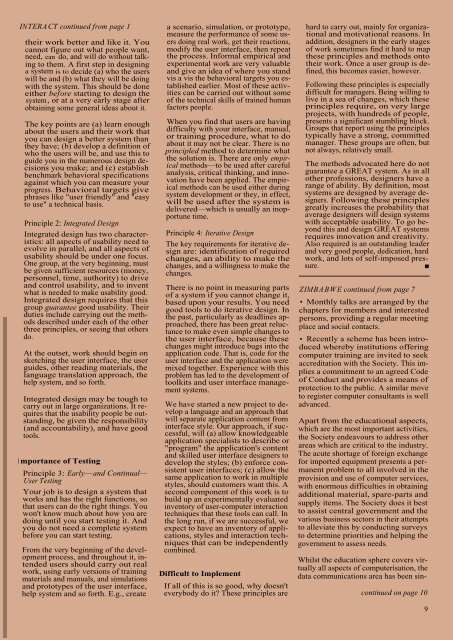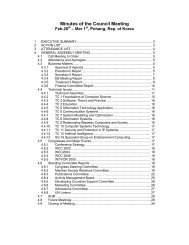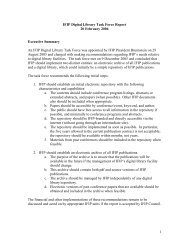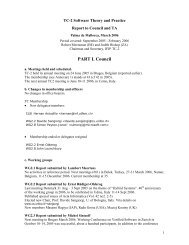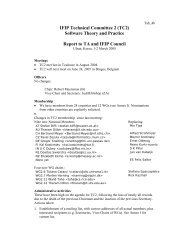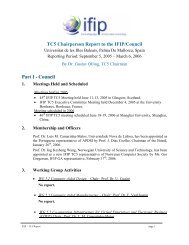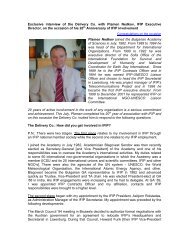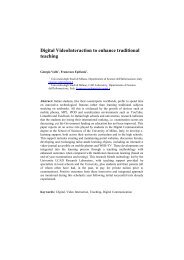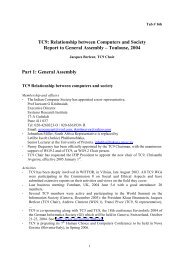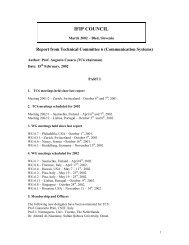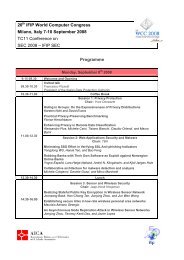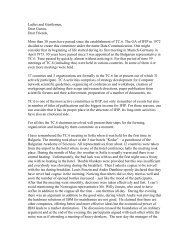March 1988 - IFIP
March 1988 - IFIP
March 1988 - IFIP
Create successful ePaper yourself
Turn your PDF publications into a flip-book with our unique Google optimized e-Paper software.
INTERACT continued from page 1<br />
their work better and like it. You<br />
cannot figure out what people want,<br />
need, can do, and will do without talking<br />
to them. A first step in designing<br />
a system is to decide (a) who the users<br />
will be and (b) what they will be doing<br />
with the system. This should be done<br />
either before starting to design the<br />
system, or at a very early stage after<br />
obtaining some general ideas about it.<br />
The key points are (a) learn enough<br />
about the users and their work that<br />
you can design a better system than<br />
they have; (b) develop a definition of<br />
who the users will be, and use this to<br />
guide you in the numerous design decisions<br />
you make; and (c) establish<br />
benchmark behavioral specifications<br />
against which you can measure your<br />
progress. Behavioral targets give<br />
phrases like "user friendly" and "easy<br />
to use" a technical basis.<br />
Principle 2: Integrated Design<br />
Integrated design has two characteristics:<br />
all aspects of usability need to<br />
evolve in parallel, and all aspects of<br />
usability should be under one focus.<br />
One group, at the very beginning, must<br />
be given sufficient resources (money,<br />
personnel, time, authority) to drive<br />
and control usability, and to invent<br />
what is needed to make usability good.<br />
Integrated design requires that this<br />
group guarantee good usability. Their<br />
duties include carrying out the methods<br />
described under each of the other<br />
three principles, or seeing that others<br />
do.<br />
At the outset, work should begin on<br />
sketching the user interface, the user<br />
guides, other reading materials, the<br />
language translation approach, the<br />
help system, and so forth.<br />
Integrated design may be tough to<br />
carry out in large organizations. It requires<br />
that the usability people be outstanding,<br />
be given the responsibility<br />
(and accountability), and have good<br />
tools.<br />
I mportance of Testing<br />
Principle 3: Early—and Continual—<br />
User Testing<br />
Your job is to design a system that<br />
works and has the right functions, so<br />
that users can do the right things. You<br />
won't know much about how you are<br />
doing until you start testing it. And<br />
you do not need a complete system<br />
before you can start testing.<br />
From the very beginning of the development<br />
process, and throughout it, intended<br />
users should carry out real<br />
work, using early versions of training<br />
materials and manuals, and simulations<br />
and prototypes of the user interface,<br />
help system and so forth. E.g., create<br />
a scenario, simulation, or prototype,<br />
measure the performance of some users<br />
doing real work, get their reactions,<br />
modify the user interface, then repeat<br />
the process. Informal empirical and<br />
experimental work are very valuable<br />
and give an idea of where you stand<br />
vis a vis the behavioral targets you established<br />
earlier. Most of these activities<br />
can be carried out without some<br />
of the technical skills of trained human<br />
factors people.<br />
When you find that users are having<br />
difficulty with your interface, manual,<br />
or training procedure, what to do<br />
about it may not be clear. There is no<br />
principled method to determine what<br />
the solution is. There are only empirical<br />
methods—to be used after careful<br />
analysis, critical thinking, and innovation<br />
have been applied. The empirical<br />
methods can be used either during<br />
system development or they, in effect,<br />
will be used after the system is<br />
delivered—which is usually an inopportune<br />
time.<br />
Principle 4: Iterative Design<br />
The key requirements for iterative design<br />
are: identification of required<br />
changes, an ability to make the<br />
changes, and a willingness to make the<br />
changes.<br />
There is no point in measuring parts<br />
of a system if you cannot change it,<br />
based upon your results. You need<br />
good tools to do iterative design. In<br />
the past, particularly as deadlines approached,<br />
there has been great reluctance<br />
to make even simple changes to<br />
the user interface, because these<br />
changes might introduce bugs into the<br />
application code. That is, code for the<br />
user interface and the application were<br />
mixed together. Experience with this<br />
problem has led to the development of<br />
toolkits and user interface management<br />
systems.<br />
We have started a new project to develop<br />
a language and an approach that<br />
will separate application content from<br />
interface style. Our approach, if successful,<br />
will (a) allow knowledgeable<br />
application specialists to describe or<br />
"program" the application's content<br />
and skilled user interface designers to<br />
develop the styles; (b) enforce consistent<br />
user interfaces; (c) allow the<br />
same application to work in multiple<br />
styles, should customers want this. A<br />
second component of this work is to<br />
build up an experimentally evaluated<br />
inventory of user-computer interaction<br />
techniques that these tools can call. In<br />
the long run, if we are successful, we<br />
expect to have an inventory of applications,<br />
styles and interaction techniques<br />
that can be independently<br />
combined.<br />
Difficult to Implement<br />
If all of this is so good, why doesn't<br />
everybody do it? These principles are<br />
hard to carry out, mainly for organizational<br />
and motivational reasons. In<br />
addition, designers in the early stages<br />
of work sometimes find it hard to map<br />
these principles and methods onto<br />
their work. Once a user group is defined,<br />
this becomes easier, however.<br />
Following these principles is especially<br />
difficult for managers. Being willing to<br />
live in a sea of changes, which these<br />
principles require, on very large<br />
projects, with hundreds of people,<br />
presents a significant stumbling block.<br />
Groups that report using the principles<br />
typically have a strong, committed<br />
manager. These groups are often, but<br />
not always, relatively small.<br />
The methods advocated here do not<br />
guarantee a GREAT system. As in all<br />
other professions, designers have a<br />
range of ability. By definition, most<br />
systems are designed by average designers.<br />
Following these principles<br />
greatly increases the probability that<br />
average designers will design systems<br />
with acceptable usability. To go beyond<br />
this and design GREAT systems<br />
requires innovation and creativity.<br />
Also required is an outstanding leader<br />
and very good people, dedication, hard<br />
work, and lots of self-imposed pressure.<br />
■<br />
ZIMBABWE continued from page 7<br />
• Monthly talks are arranged by the<br />
chapters for members and interested<br />
persons, providing a regular meeting<br />
place and social contacts.<br />
• Recently a scheme has been introduced<br />
whereby institutions offering<br />
computer training are invited to seek<br />
accreditation with the Society. This implies<br />
a commitment to an agreed Code<br />
of Conduct and provides a means of<br />
protection to the public. A similar move<br />
to register computer consultants is well<br />
advanced.<br />
Apart from the educational aspects,<br />
which are the most important activities,<br />
the Society endeavours to address other<br />
areas which are critical to the industry.<br />
The acute shortage of foreign exchange<br />
for imported equipment presents a permanent<br />
problem to all involved in the<br />
provision and use of computer services,<br />
with enormous difficulties in obtaining<br />
additional material, spare-parts and<br />
supply items. The Society does it best<br />
to assist central government and the<br />
various business sectors in their attempts<br />
to alleviate this by conducting surveys<br />
to determine priorities and helping the<br />
government to assess needs.<br />
Whilst the education sphere covers virtually<br />
all aspects of computerisation, the<br />
data communications area has been sincontinued<br />
on page 10<br />
9


